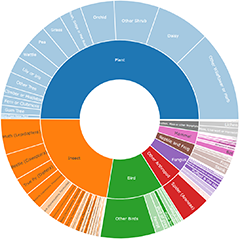Puffballs & the like
At maturity, the fruitbodies of the fungi in this group generally contain prodigious quantities of powdery spores. The fruitbodies may be spherical to pear-shaped or somewhat columnar in shape and range from less than a centimetre to over 30 centimetres in extent. Spores are mostly some shade of brown, from pale yellow-brown to dark brown, depending on species.
Almost all species produce their fruitbodies on the ground, a few produce them on on wood.
In the following hints you see examples of useful identification features and a few of the more commonly seen genera in which at least some species (not necessarily all) show those features.
Hints
Spore mass lilac: Calvatia.
Fruitbody over 30 centimetres in diameter: Calvatia.
Warning
If you have a flattish fruitbody, with purplish-black powdery spores inside a thin, brittle crust - check the slime mould Fuligo septica.
Announcements
There are currently no announcements.
Discussion
Unverified Fruitbody thick walled, splitting from the top
Scleroderma sp.
Scleroderma sp.
Scleroderma sp.
Top contributors
- trevorpreston 52
- TimL 44
- Teresa 35
- AlisonMilton 33
- JackyF 30
- KenT 26
- Mike 22
- Heino1 19
- AaronClausen 19
- Aussiegall 17
Top moderators
- Heino1 308
- Heinol 97
- MichaelMulvaney 89
- KenT 65
- Heino 54
- Teresa 48
- Pam 28
- Csteele4 27
- CanberraFungiGroup 22
- JTran 15






